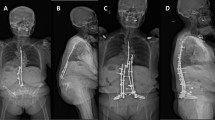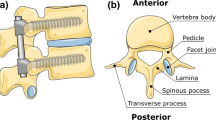Abstract
Although application of intraoperative computer navigation technique had been integrated into placement of pedicle screws (PSs) in thoracic fusion for years, its security and practicability remain controversial. The aim of this study is to evaluate the accuracy, the operative time consumption, the amount of intraoperative blood loss, time of pedicle insertion and the incidence of complications of thoracic pedicle screw placement in patients with thoracic diseases such as scoliosis and kyphosis. Pubmed, Web of Knowledge, and Google scholar were searched to identify comparative studies of thoracic pedicle screw placement between intraoperative computer navigation and fluoroscopy-guided navigation. Outcomes of malposition rate, operative time consumption, insertion time, intraoperative blood loss, and the incidence of complications are evaluated. Fourteen articles including 1723 patients and 9019 PSs were identified matching inclusion criteria. The malposition rate was lower (RR: 0.33, 95 % CI: 0.28–0.38, P < 0.01) in computer navigation group than that in fluoroscopy-guided navigation group; the operative time was significantly longer [weighted mean difference (WMD) = 23.66, 95 % CI: 14.74–32.57, P < 0.01] in computer navigation group than that in fluoroscopy-guided navigation group. The time of insertion was shorter (WMD = −1.88, 95 % CI: −2.25– −1.52, P < 0.01) in computer navigation group than that in fluoroscopy-guided navigation group. The incidence of complications was lower (RR = 0. 23, 95 % CI: 0.12–0.46, P < 0.01) in computer navigation group than that in the other group. The intraoperative blood loss was fewer (WMD = −167.49, 95 % CI: −266.39– −68.58, P < 0.01) in computer navigation group than that in the other. In conclusion, the meta-analysis of thoracic pedicle screw placement studies clearly demonstrated lower malposition rate, less intraoperative blood loss, and fewer complications when using computer navigation. This result provides strong evidence that computer technology could be safer and more reliable than fluoroscopy-guided navigation.






Similar content being viewed by others
References
Abe Y et al (2011) A novel cost-effective computer-assisted imaging technology for accurate placement of thoracic PSs. J Neurosurg Spine 15(5):479–485
Ailawadhi P, Agrawal D, Satyarthee G et al (2011) Use of O-arm for spinal surgery in academic institution in India: experience from JPN apex trauma centre. Neurol India 59(4):590–593
Allam Y et al (2013) Computer tomography assessment of pedicle screw placement in thoracic spine: comparison between free hand and a generic 3D-based navigation techniques. Eur Spine J
Esses SI, Sachs BL, Dreyzin V (1993) Complications associated with the technique of pedicle screw fixation. A selected survey of ABS members. Spine 18:2231–2238
Fu TS, Wong CB, Tsai TT et al (2007) Pedicle screw insertion: computed tomography versus fluoroscopic image guidance. Int Orthop
Gelalis ID, Paschos NK, Pakos EE et al (2012) Accuracy of pedicle screw placement: a systematic review of prospective in vivo studies comparing free hand, fluoroscopy guidance and navigation techniques. Eur Spine J 21:247–255
Haberland N, Ebmeier K, Hliscs R et al (1999) Intraoperative CT in image-guided surgery of the spine. Medicamundi 43:24–31
Hartl R, Lam KS, Wang J et al (2013) Worldwide survey on the use of navigation in spine surgery. World Neurosurg 79(1):162–172
Hicks JM, Singla A, Shen FH et al (2010) Complications of pedicle screw fixation in scoliosis surgery: a systematic review. Spine (Phila Pa 1976) 35(11):E465–E470
Houten JK, Nasser R, Baxi N (2012) Clinical assessment of percutaneous lumbar pedicle screw placement using the O-arm multidimensional surgical imaging system. Neurosurgery 70(4):990–995
Huang Y et al (2009) Application of C-arm X-ray navigation and CT navigation in thoracolumbar pedicle screw fixation, a contrast observation. Shangdong Med 14:5–7
Katonis P, Christoforakis J, Aligizakis AC et al (2003) Complications and problems related to pedicle screw fixation of the spine. Clin Orthop 411:86–94
Kosmopoulos V, Schizas C (2007) Pedicle screw placement accuracy: a meta-analysis. Spine (Phila Pa 1976) 32:E111–E120
Laine T et al (2000) Accuracy of pedicle screw insertion with and without computer assistance: a randomised controlled clinical study in 100 consecutive patients. Eur Spine J 9(3):235–240
Laine T, Schlenzka D, Mäkitalo K et al (1997) Improved accuracy of pedicle screw insertion with computer-assisted surgery. Spine 22:1254–1258
Lekovic GP, Potts EA, Karahalios DG et al (2007) A comparison of two techniques in image-guided thoracic pedicle screw placement: a retrospective study of 37 patients and 277 PSs. J Neurosurg Spine 7(4):393–398
Li Q, Tian Q, Liu B et al (2007) Percutaneous pedicle screw fixation in thoracic-lumbar fracture using mini-invasive pedicle screw system guided by navigation. China Med Mag 87(19):1339–1341
Lonstein JE, Denis F, Perra JH et al (1999) Complications associated with PSs. J Bone Joint Surg Am 81- A:1519–1528
Luther, N et al (2013) Comparison of navigated versus non-navigated pedicle screw placement in 260 patients and 1434 screws: screw accuracy, screw size, and the complexity of surgery. J Spinal Disord Tech
Makino K, Fujiwara H et al Morphometric analysis using multiple anarreconstructed CT of the lumbar pedicle in patients with degenerative lumbar scoliosis is characterized by a Cobb angle of 30 degrees or greater. J Neurosurg Spine 17(3):256–262. 102
Merloz P et al (1998) Computer-assisted surgery: automated screw placement in the vertebral pedicle. Chirurgie 123(5):482–490
Merloz P, Troccaz J, Vouaillat H et al (2007) Fluoroscopy-based navigation system in spine surgery. Proc Inst Mech Eng [H] 221(7):813–820
Panjabi MM, Takata K, Goel V et al (1991) Thoracic human vertebrae. Quantitative three-dimensional anatomy. Spine 16:888–901
Rajasekaran S et al (2007) Randomized clinical study to compare the accuracy of navigated and non-navigated thoracic PSs in deformity correction surgeries. Spine (Phila Pa 1976) 32(2):E56–E64
Ringel F, Stoffel M, Stuer C et al (2006) Minimally invasive transmuscular pedicle screw fixation of the thoracic and lumbar spine. Neurosurgery 59(4 Suppl 2):ONS361-6, discussion ONS366-7
Sahoo MM, Mahapatra SK, Sethi GC et al (2012) Posterior-only approach surgery for fixation and decompression of thoracic lumbar spinal tuberculosis: a retrospective study. J Spinal Disord Tech 25(7):217–223
Sasso RC, Garrido BJ (2007) Computer-assisted spinal navigation versus serial radiography and operative time for posterior spinal fusion at L5-S1. J Spinal Disord Tech 20(2):118–122
Seller K et al (2005) Prospective screw misplacement analysis after fluoroscopy-guided and navigated pedicle screw implantation. Biomed Technol (Berl) 50(9):287–292
Shin MH et al (2012) Accuracy and safety in pedicle screw placement in the thoracic and lumbar spines: comparison study between fluoroscopy-guided C-Arm fluoroscopy and navigation coupled with O-Arm(R) guided methods. J Korean Neurosurg Soc 52(3):204–209
Steinmann JC, Herkowitz HN, ei-Kommons H et al (1993) Spinal pedicle fixation: confirmation of an image-based technique for screw placement[J]. Spine 18(13):1856–1861
Su BW, Kim PD, Cha TD et al (2009) An anatomical study of the mid-lateral pars relative to the pedicle foot print in the lower lumbar spine. Spine (Phila Pa 1976) 34(13):1355–1362
Tian NF, Huang QS, Zhou P, Zhou Y, Wu RK, Lou Y et al (2011) Pedicle screw insertion accuracy with different assisted methods: a systematic review and meta-analysis of comparative studies. Eur Spine J 20:846–859
Tian NF, Xu HZ (2009) Image-guided pedicle screw insertion accuracy: a meta-analysis. Int Orthop 33:895–903
Tormenti MJ et al (2010) Intraoperative computed tomography image-guided navigation for posterior thoracolumbar spinal instrumentation in spinal deformity surgery. Neurosurg Focus 28(3):E11
Torres J et al (2012) Screw placement accuracy for minimally invasive transforaminal lumbar interbody fusion surgery: a study on 3-D neuronavigation-guided surgery. Global Spine J 2(3):143
Vaccaro AR, Rizzolo SJ, Allardyce TJ, Ramsey M, Salvo J, Balderston RA, Cotler JM (1995) Placement of PSs in the thoracic spine. Part I: morphometric analysis of the thoracic vertebrae. J Bone Joint Surg Am 77:1193–1199
Verma R, Krishan S, Haendlmayer K, Mohsen A (2010) Functional outcome of computer-assisted spinal pedicle screw placement: a systematic review and meta-analysis of 23 studies including 5,992 pedicle screws. Eur Spine J 19:370–375
Waschke A et al (2013) CT-navigation versus fluoroscopy-guided placement of PSs at the thoracolumbar spine: single center experience of 4,500 screws. Eur Spine J 22(3):654–660
Wu H et al (2010) Pedicle screw placement in the thoracic spine: a randomized comparison study of computer-assisted navigation and fluoroscopy-guided techniques. Chin J Traumatol Chin Med Assoc 13(4):201–205
Zausinger S, Scheder B, Uhl E et al (2009) Intraoperative computed tomography with integrated navigation system in spinal stabilizations. Spine (Phila Pa1976) 34(26):2919–2926
Zhang B, et al (2006) The application of 3D navigation-assisted thoracic-lumbar PSs placement in interbody fusion. Anhui Med Univ
Zong Z (2009) A comparative study of application between three-dimensional navigation assisted and X-ray fluoroscopy in thoracolumbar pedicle screw fixation. Beijing Univ Chin Med
Author information
Authors and Affiliations
Corresponding author
Ethics declarations
Conflict of interest
The authors declare that they have no competing interests.
Additional information
Comments
Kiyoshi Ito, Matsumoto, Japan
In recent years, the significant advances of the surgery supporting device is remarkable in the field of the spinal surgery.
Authors showed the significant excellence of computer navigation system from the previous report between two groups. As written in conclusion, I want to know if there is data on the differences of the radiation exposure in both. It is very important to know the difference of the radiation exposure in accordance to the advent of these devices.
Rights and permissions
About this article
Cite this article
Meng, Xt., Guan, Xf., Zhang, Hl. et al. Computer navigation versus fluoroscopy-guided navigation for thoracic pedicle screw placement: a meta-analysis. Neurosurg Rev 39, 385–391 (2016). https://doi.org/10.1007/s10143-015-0679-2
Received:
Revised:
Accepted:
Published:
Issue Date:
DOI: https://doi.org/10.1007/s10143-015-0679-2




